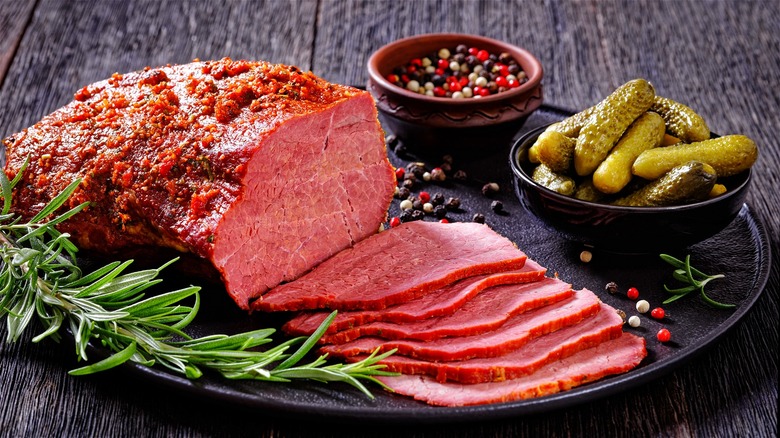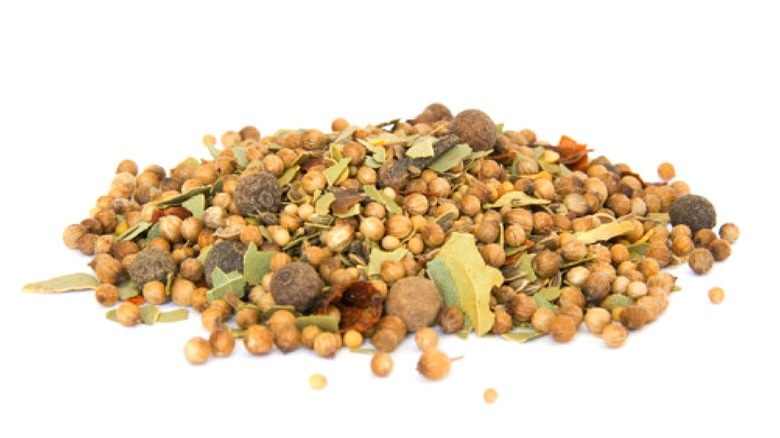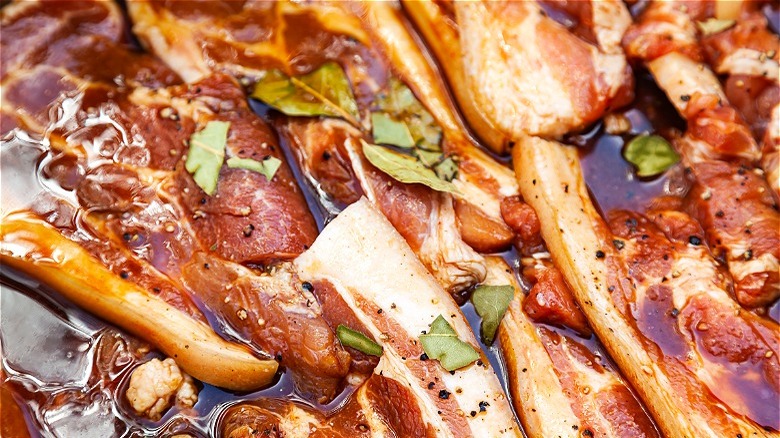Pickling Meat Is An Old-School Way To Soak In More Flavor
For many culinary masters and home chefs, flavorful meat is one of the necessary components of a satisfying meal. Of course, the simple act of pan-frying, grilling, or baking can produce a number of different flavor notes in your favorite cuts of meat, thanks to browning and caramelization. Many of us also utilize marinades for grand dishes, such as Tuscan flank steak with lemon-rosemary sauce. But what if there was a way to add more flavor to meat with a time-honored technique that's been around for thousands of years?
We're now used to relying on refrigerators to store all of our precious cuts of meat. But through the first half of the 20th century, people had to get creative when storing food-related perishables. Even though pickling is most commonly associated with preservation, with the right assortment of spices, pickling can add loads of flavor to a number of meats, too.
Pickling has both preservation and flavor-inducing properties
There's a solid explanation for why pickling has been used time and time again by our ancestors. While a few men knew how to pickle just about any vegetable for the voyages led by Christopher Columbus in the 1400s, they also made pickled meats. These were not only infused with a curated set of spices but also remained free of potential bacterial growth. These specially preserved meats were used to feed those busy exploring the new world without the risk of illness. Even Napoleon Bonaparte stood behind pickles for their supposed health benefits and long-term shelf life.
Now that we have refrigerators, however, pickling has become more of a flavor-fueled preparation method. So, how does pickling work exactly?
In the most general sense, pickling involves the submersion of fresh foods and/or perishables in a solution composed of salt, sugar, various spices, vinegar, and water. Once prepared correctly, this acidic brine works to ward off any bacterial growth. And with the varying amounts of spices used, it makes for quite flavorful foods. Besides the necessary salt and sugar, you have a wide assortment of spices to choose from, including garlic, peppercorns, and mustard seeds. The spices, combined with a salty finish and tangy acidic bite, are sure to make any cut of meat more delicious.
How to pickle meat for an added flavor boost
Now that you have a more concrete idea of what pickling actually is, how can you pickle your next batch of pork or lamb? If you're used to brine-soaked cucumbers and quick pickled garlic jalapeños, you may be ready to take your next cut of meat to new heights. First, make sure your fresh meat selections are cut into smaller pieces. For roughly 2 pounds of meat, bring a few cups of water and some white or apple cider vinegar to a boil, along with a good helping of salt, sugar to balance the liquid's acidity, and any pickling spices of your choosing. Once the liquid has boiled for at least five minutes, let the mixture cool to room temperature.
From there, submerge the fresh chunks of meat into the brine, cover, and allow the meat to pickle in the refrigerator for three days before cooking and enjoying. You can also store meat with the pickling liquid in resealable plastic bags, flipping the bags every so often during the pickling process to make sure every inch of the meat interacts with the seasoned vinegar. Just keep in mind that the longer pickled meat is left in the refrigerator, the more developed the final flavor will be.
The tartness of the vinegar, combined with a specialized assortment of savory spices, is sure to impart a great deal of flavor. This longtime preservation technique works equally well as a surefire flavor enhancer.


